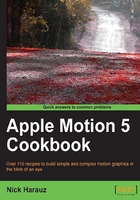
Applying a Glow filter to a layer
For those of you from Final Cut X, applying effects to your projects is probably second nature but many of you may not realize that the vast majority of the effects in the Media Browser come directly from Motion. At any time, if you Ctrl +click or right-click these effects, you would see an option to open a copy of it in Motion, as shown in the following screenshot:

Let's see how easy it is to add a filter to a clip in Motion.
How to do it...
- From this chapter's project folder, double-click and open the
02_03project.. The project consists of an Aqua Ball from Motion's Content library. It has been scaled up in size. We want to add a filter to it. Make sure the Aqua Ball is selected in the Layers tab. - Click on the Library tab. Locate the Filters category and select it. Select the Glow subcategory. There are eight different glows to choose from, as shown in the following screenshot:

- Select the Light Rays filter and click on the Apply button at the top of the Library tab. The filter is now applied to the Aqua Ball.
- With the Aqua Ball selected, press F3 to go to the Filters tab of the Inspector. Notice how the Light Rays filter is attached to your image. It seems to affect the brightest areas of the Aqua Ball. First, let's play with the Mix slider by dragging it to
0and slowly back to100, as indicated in the following screenshot:
- Experiment with each of the other parameter sliders to get a feel for the effect on the Aqua ball (threshold and radius have a greater effect than the other two parameters). I used
150for Amount,8for Glow, and2for Expansion. The results can be seen in the following screenshot:
- Turn the filter on and off to see the before and after of the results by clicking the blue square for the filter in the Layers tab.
There's more…
The magic of filters lies in our ability to keyframe them and create animation. Lucky for us, the majority of Motion parameters on filters are keyframable!
Keyframing filters
While the result of the previous example is a static effect, notice that if you hover your mouse over the right-hand side of any of the parameters in the Filters tab, a diamond shape pops up, as indicated in the following screenshot. Filters become even more powerful when we make variable changes to them over time. Keyframing is our tool for creating animation. Two keyframes at different places in time and with different values result in an animation. Filters can even be used as transitions between clips to create dynamic effects. We'll cover more of this in Chapter 4, Making It Move with Keyframes.

Don't sweat the filters
There are 132 filters in Motion's library! Don't sweat it if you don't know what each one does. Your desire to add filters and play with the parameters is all you need to discover all the options that are out there. So start exploring!
See also
- The Copying filters and applying filters to a group recipe.
- The Controlling the filter order recipe.